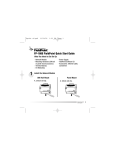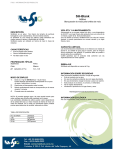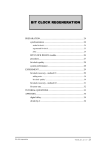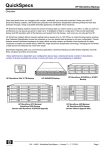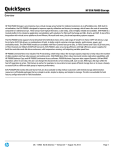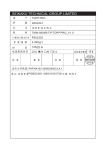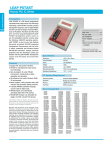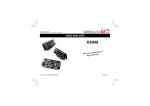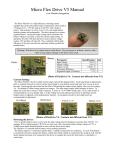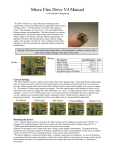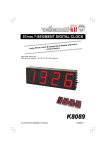Download k6000 microprocessor controller / timer
Transcript
K6000 MICROPROCESSOR CONTROLLER / TIMER ASSEMBLY 3 H6000B-ED2 _________________________________________________________________________________________________________________________________________________________ VELLEMAN KIT NV Legen Heirweg 33 9890 Gavere Belgium http://www.velleman.be 2 _________________________________________________________________________________________________________________________________________________________ MICRO PROCESSOR CONTROLLER/TIMER In addition to the features of an ordinary week/day switching clock, this jewel of a controller allows controlling independant temperatures through one or all four of its outputs. For every temperature to be measured (up to 4) a separate sensor K6001 or K6003 is required, which allows to install the controller itself distant from the measuring point. When a sensor becomes defective, the controller outputs a message on the screen and switches the corresponding output off. Any relevant information like output number, temperature or on/off, day and time is displayed through an illuminated LC display. Programming the device (up to 200 steps!) is done through a clear "menu" structure. Just like with an ordinary thermostat you can readjust the preprogrammed settings temporarily and set a hysteresis per output. In order to save programming work in the case of a mains voltage drop, the print has been designed such that it can be fitted with a NiCd or ordinary 9V battery. TECHNICAL DATA - 4 noisefree relay outputs max. 5A/220V - 4 opto coupler inputs for temperature sensors K6001 or K6003 - Allows to feed up to four sensors type K6001 - Detection of the presence and operation of temperature sensors - 16 character LCD screen (illuminated) - 50 program steps per output (200 in total) - Allows either week or day program - Programming resolution: 1 minute and 0.1° - Hysteresis adjustable from 0 to 25° (0,1° per step) separately per output. - Accuracy: +/-0.1° - Measuring range: -40° to +150° - Sampling frequency: 1 sec. - 24 hour clock with day indication - LED indication of the output states - Standard version intended for building in - Separately obtainable housing B6000 for building up - Supply voltage: mains - Memory back up: 24 hours with 9V battery / 8 hours with 4.8V NiCd battery - Dimensions (front panel): 235X120mm. Building-in depth min. 50mm Modifications reserved 3 _________________________________________________________________________________________________________________________________________________________ ASSEMBLY A) Assembly of the keyboard module P6000S - Fit D5 through D9, 1N4148 type small signal diodes or equivalent. Pay attention to the polarity! - Fit the push buttons SW1 through SW5, with their bodies AGAINST the pcb. ATTENTION: Don't warm up the terminals of the push buttons too long, because this might damage the push buttons irreparably! B) Assembly of the basic module P6000B - Fit the wire jumpers marked J on the pcb The wire jumper between IC3 and IC5 (dotted-lined and marked "WRITE PROTECT") must be fitted in the first instance. If afterwards you want to prevent the established program from getting overwritten, then you'll have to cut this wire jumper. Wire jumper JC should not be fitted for the present. Fit the following components when using a 9V battery: - D10, diode from the 1N4148 series or equivalent. Pay attention to the polarity! - ZD2, 3.3V zener diode. Pay attention to the polarity! - T6, BC557C type transistor or equivalent. Fit the following components when using a NiCd battery: - Wire jumper JC - D27, diode from the 1N4148 series or equivalent. Pay attention to the polarity! - D28, diode from the 1N4000 series or equivalent. Pay attention to the polarity! Fit the following resistors: - R1 through R6, 1K (brown, black, red) - R7, 4K7 (yellow, violet, red) - R8 through R12, 47K (yellow, violet, orange) - R22 through R31, 4K7 (yellow, violet, red) - R32, 10M (brown, black, blue) - R33, 1K (brown, black, red) - R34, 680 ohm (blue, grey, brown) - R35, 1/2W 220 ohm (red, red, brown) Fit the following diodes: (pay attention to the polarity) - D1 through D4, diode from the 1N4148 series or equivalent. - D11 through D15, diode from the 1N4148 series or equivalent - D16 through D25, diode from the 1N4000 series. - ZD1, 7.5V zener diode. Fit the IC sockets for IC1 through IC9 Fit push button SW6 (see also 'assembly of the keyboard module') 4 _________________________________________________________________________________________________________________________________________________________ Fit the 4K7 resistor network RA1. Such a network consists of nine resistors connected together at one end and accomodated in one single housing. The common is marked with a notch, a dot or a stripe, and must correspond with the hole marked "C". Fit 2 pcb pins for GND and TP Fit the following transistors: T1 through T5, BC547 type or equivalent. Fit the 4.1943MHz crystal X1. Fit the 7806 type voltage regulator VR1, with its metal back towards D26. Fit the following capacitors: C1, 5pF ceramic (sometimes marked 4.7) C2, 39pF ceramic C3 through C5, 100nF (sometimes marked u1 or 104) C6, 10uF electrolytic capacitor. Pay attention to the polarity! C7, 2200uF electrolytic capacitor. Pay attention to the polarity! C8 and C9, 470uF. Pay attention to the polarity! Fit the fuse holder F1 and fit it with a 0.4A fuse. Fit the 4 six-pole screw connectors J1 through J4. Fit the relays RY1 through RY4. Assembly of the noise suppressing networks for the outputs: - Fit the capacitors C10 through C13, 100nF 400V or higher. Fit these capacitors vertically and with only one lead connected for the present. - Fit the following 220 ohm 1/2W resistors also vertically and with only one lead connected for the present: When using the "normally closed (NC)" contact of the relay, fit resistor R37, R39, R41, R43 for output 1, 2, 3, 4 respectively. When however using the "normally open (NO)" contact, fit resistor R36, R38, R40, R42 for output 1, 2, 3, 4 respectively. Then connect the free extremities of each capacitor-resistor pair together and cut them. 5 _________________________________________________________________________________________________________________________________________________________ Apply an extra layer of solder to the soldered copper traces. Connect the 9V battery holder (when not using a NiCd battery) to the - points (black wire) and to one of the two + holes (red wire) of E1. Fit the 12V/100mA transformer TRANSFO 2. Fit the 2X6V (12V) / 300mA transformer TRANSFO 1. Check the position of the 12V output. Fit the following components on the solder side. Do this very carefully because afterwards some of these components will have to fit under or to pass through the front panel. Be also careful when soldering because for some of the components you have to heat close by the component body: - RV1, 4K7 (5K) trimming potentiometer. - CV1, 30pF trimming capacitor. - the LED's LD1 through LD5 (LD5= red) with their tops at a height of 14mm above the pcb surface. To do so first solder one lead of the LED, then correct its position and finally solder its second lead. Pay attention to the polarity, the shortest lead should correspond with the flat side of the circle on the pcb overprint. At this point, before proceeding, check the whole mounting once more thoroughly as well as the solder side for soldering mistakes! Fitting the keyboard module onto the basic module ca. 7mm P6000S P6000S 10mm SPACER P6000S P6000S SOLDERSIDE SOLDERSIDE P6000B P6000B SOLDER Solder six uninsulated wires to the points KB, S1 through S5 at the solder side of the keyboard pcb. These wires will serve afterwards to make the connections with the basic module. REMARK: Cut the superfluous extremities of these wires FLUSH with the pcb surface at the component side! Fit the keyboard pcb into the four holes at the solder side of the basic pcb. See that the connection wires (KB, S1..S5) pass through the basic pcb too and that the connection point KB corresponds with the hole marked "1" at the solder side of the basic pcb. Fix the keyboard pcb using four M2.5 nuts. See that the pcb is perfectly parallel with the basic pcb, because only then you can solder and cut the connections at the component side of the basic pcb. 6 _________________________________________________________________________________________________________________________________________________________ Fitting the display onto the basic module LCD MODULE M2.5 BOLT INSULATING SLEEVE 5mm SPACER SOLDERSIDE M2.5 NUT P6000B Check that, where the display has to be fitted, the solder points on the basic pcb are cut short. BE SHURE TO CUT the solder points from SW6!. Fit the display at the solder side of the basic pcb using four M2.5 bolts together with four 5mm spacers and an additional insulation ring. Fix the display using four M2.5 nuts at the component side of the basic pcb and check that the display is at right angles to the basic pcb. Now connect by means of uninsulated wires, the display with the base PCB (see fig.). LCD TYPE B LCD TYPE A . Fit the following IC's: IC1, VK6000 or PIC16C57 type, with its notch towards the transformer. IC2, HCT4060 type or equivalent, with its notch towards IC3. IC3, 74HC373 type or equivalent, with its notch towards the pcb edge. IC4, 74HC373 type or equivalent, with its notch towards SW6. IC5, 6116 type or equivalent, with its notch towards IC3. Fit IC6 through IC9, TIL111 or 4N27 type opto couplers or equivalent, with their towards C8. notches REMARK: For IC5 (RAM IC for program-steps storage) you can also use an EEPROM type 2816. Before fitting the front panel and the battery we will first test the circuit. 7 _________________________________________________________________________________________________________________________________________________________ Remedies in the case of malfunction caused by the relays If the relays are used to switch alternating voltage, it may be necessary to suppress them. Figure 5.1 shows how to suppress resistive loads (lamp, resistor, ...), Figure 5.2 shows how to suppress inductive loads (transformer, motor, ...) and figure 5.3 applies in case all the above solutions fail. TEST AND CONNECTION a) Test without temperature sensors: Connect the mains voltage to the points MAINS. ATTENTION: CERTAIN POINTS OF THE PCB NOW CARRY DANGEROUS MAINS VOLTAGE. Normally, the display should show the text "1;OFF Mo 00:00" now. Should this not be the case, just turn the contrast trimming potentiometer. Using the push buttons SW2 and SW3 (second and third from the left) you now should be able to "select" among the four outputs. (the output number is the first digit on the display) ATTENTION: Should the controller not work, then try to unblock by just pressing the RESET push button next to IC4. This RESET button may be used every time the controller 'locks up'. Attention, pressing the RESET button erases the memory content. b) Test with temperature sensors: (K6001 or K6003) Before doing the following test, first disconnect the mains voltage. Connect one or more sensors to the points SENSOR1 through SENSOR4, and branch off the power supply for the K6001 type sensors from the points Vsensor + and -. (see fig. 6.0) The power supply for the K6003 type sensors has to be made separately, or replace TRANSFO 2 by a 2X6V/1A type (see fig. 6.1). Now switch the power back on. Normally, for these outputs equipped with a sensor, the display should indicate a temperature now, instead of "OFF" (selection of the outputs is again done using the buttons SW2 and SW3). The display indicating "SENSOR ERROR" or simply keeping indicating "OFF" for a certain output means that this sensor is defective or wrongly connected. See USER MANUAL if you want to test all the functions before fixing the front panel. After a successful test, you may fit a 9V battery. Fix the battery with a binder or with a piece of two-sided adhesive tape. When using a NiCd battery you may fit two 2.4V batteries or one 4.8V battery in the place marked E1. REMARK: With a NiCd battery, the memory back-up will not work until the controller will have been powered on for a few weeks. (this is the time needed to charge the NiCd battery). 8 _________________________________________________________________________________________________________________________________________________________ ADJUSTMENT ATTENTION: WHEN THE CIRCUIT IS POWERED ON, A LOT OF POINTS CARRY DANGEROUS MAINS VOLTAGE. As the clock of the controller must continue working during a power failure, we opted for an oscillator based clock built round a crystal and a devider. The disadvantage of this system versus a 50Hz mains time base is that it has to be adjusted. If you don't adjust the clock, it may go wrong after a certain period of time. Adjusting can be done in two different ways: 1) Using a frequency counter: Connect the counter to the points GND(earth) and TP. The frequency measured must be of 256KHz i.e. a period of 3.90625mS. The time base can be adjusted using trimming capacitor CV1. 2) at sight: Of course the first method is the best one but as only few of us possess a frequency counter, the second method will be the most frequently used one. Turn the trimming capacitor CV1 to its centre position (the fixed and movable plates must overlap by about half their surfaces). Should in course of time the clock go wrong, then you would have to readjust the trimming capacitor CV1 a little. To that end the front panel contains a hole through which the clock can be adjusted. FIXING THE FRONT PANEL M3 BOLT 8mm THREAD TUBE P6000B SOLDERSIDE 5mm THREAD TUBE M3 BEVELLED HEAD BOLT ALU FRONT PANEL Fit each of the six sunk holes with an 8mm and 10mm spacer using an M3 bevelled head bolt. ATTENTION: Fix these screws WELL because, with the foil sticked, they will no longer be accessible. Before sticking the self-adhesive foil to the aluminium front pate, check that the surface contains no wire-edges, dirt or other obstacles. Position the foil onto the front panel (pay attention to the LED windows OUT1, ...). Provisionally adhere one half of the foil using adhesive tape. Remove the protective sheet from the other half and stick this side, then remove the adhesive tape and the protective sheet from the first half and stick this half to the aluminium front plate too. Fit the basic module onto the thread tubes using six M3 bolts and check that the indication LED's and LCD display are well positioned, also check the operation of the push buttons. The controller is now ready for use. 9 _________________________________________________________________________________________________________________________________________________________ LOAD NO MAINS 220 Ohm 0.5W 22...100nF COM K6000/K6010 400V FIG. 5.1 : RESISTIVE LOADS 220 Ohm 100nF VDR 0.5W 400V MAINS LOAD NO COM K6000/K6010 FIG. 5.2 : INDUCTIVE LOADS - Vext + LOAD MAINS NO COM K6000/K6010 FIG. 5.3 : WITH ADDITIONAL DC-RELAY 10 _________________________________________________________________________________________________________________________________________________________ K6000/K6010 MAINS Vsensor + SENSOR4 SENSOR3 SENSOR2 SENSOR1 + + + + MAINS SENSOR OUT - + K6001 SENSOR OUT - + K6001 SENSOR OUT - + K6001 SENSOR OUT - K6001 + FIG. 6.0 11 _________________________________________________________________________________________________________________________________________________________ K6000/K6010 TRANSFO2 6 0 6V/1A 6 MAINS Vsensor + SENSOR4 SENSOR3 SENSOR2 SENSOR1 + + + + MAINS 6V/1A SENSOR OUT - + K6003 SENSOR OUT - + K6003 SENSOR OUT - + K6003 SENSOR OUT - K6003 12 + FIG. 6.1 D5 D6 D7 D8 D9 NC 4 NO NC 3 NO NC 2 NO NC 1 NO SLOW 0.4A F1 J2 J1 C12 C11 R43 RY4 RY3 RY2 RY1 12VAC TRANSFO2 R42 C13 R40 R41 R38 R39 R37 R36 D22 LD1 T2 LD2 T3 LD5 J LD4 MAINS J 6 J3 + - + - 1 D15 6 1 IC9 TRANSFO1 0 12VAC + D14 IC8 C7 - J4 1 + - D13 IC7 D17 D19 D18 D16 VR1 C3 9 VOLT BATTERY ZD2 D26 + 1 J J J J IC6 C9 D12 C4 Vsensor SENSOR4 SENSOR3 SENSOR2 SENSOR1 - C8 E1 1X4.8V OR 2X2.4V Ni-Cd BATTERY VELLEMAN P6000B'4 LD3 T4 T6 D10 D27 R12 D1 R1 D2 R2 D3 R3 D4 R4 R33 J R31 IC2 256Hz TP J J D11 SW6 RESET J RA1 J R32 CV1 C5 CLOCK C1 ADJUST C X1 1 J 1 J J IC4 C2 C6 J 1 WRITE PROTECT J J IC3 R5 GND J D20 R22 R23 R24 R25 LD- JC J J S5 S4 S3 S2 S1 KB C10 D25 SW5 D24 SW4 D23 R9 D21 R8 SW3 R11 KB 1 2 3 4 5 R10 MAN J IC1 LDKEYBOARD PCB ZD1 R6 R30 RV1 DISPLAY CONTRAST T5 J J DY1 LCD MODULE IC5 R26 R27 R28 R29 1 R34 SW2 +LD LD+ D7 D6 D5 D4 D3 D2 D1 D0 E RW RS Vo Vdd GND R7 SW1 R35 +LD T1 _________________________________________________________________________________________________________________________________________________________ 1 VELLEMAN P6000S'2 ENTER RUN 13 _________________________________________________________________________________________________________________________________________________________ 14
















